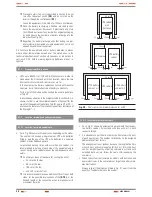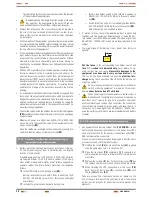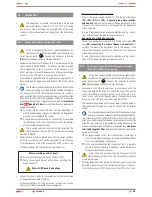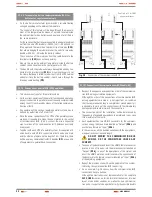
50
–
Inverters are shutdown or in start up process.
• Voltage Master and Slave («Mst. Volt», «Slv. Volt», «Slv. Vt.Rsv»).
Master manages the status of the own solid state static by-
pass switch and controls the inverter voltage, as well as the
one of the Slave equipments.
Equipments are sharing the load in inverter. Therefore:
–
Output switches
(Q2)
are to «On» position.
–
Inverter are operative and solid state switches are on
inverter.
6.3.
SHUTDOWN OF AN EQUIPMENT FROM PARALLEL
SYSTEM.
• Turn the output switch
(Q2
) of the UPS to shutdown, to posi-
tion «Off». The screen 0.1 of the LCD panel will display:
UPS: Normal, Invert.
CFG: Paral. Not connected
screen 0.1
6.4.
TO START UP THE UPS OF PREVIOUS SECTION.
• Start up the inverter by means of the keypad of the control
panel
(3)
(see Fig. 40).
From main screen press
(
)
key to access to «CONTROL AND
STATUS OF THE UNIT» submenu (screen 1.0), and then press
(
)
key. The screen 1.1 will be displayed, asking you to start the
equipment up by pressing
(ENT)
. Do so, and then validate the
operation by pressing
(ENT)
again. See the diagram of Fig. 39.
The UPS will take about 30 seconds to be operative again.
• Turn the output switch
(Q2
) of the UPS, to position «On».
6.5.
COMPLETE SHUTDOWN OF THE UPS OR SYSTEM.
• Shutdown the loads.
• If the equipment or parallel system has an outgoing distribution,
turn its switches «Off».
• Shutdown the inverter of the UPS.
Through the keypad of control panel
(3)
(see Fig. 40) and from
main screen press
(
)
key to access to «CONTROL AND
STATUS OF THE UNIT» submenu (screen 1.0), and then press
(
)
key. The screen 1.3 will be displayed, asking you to shut-
down the equipment by pressing
(ESC)
. Do so, and then vali-
date the operation by pressing
(ENT)
. See the diagram of Fig.
39.
In parallel systems is necessary to act over one of them
only.
Consider that the UPS or system is still supplying output voltage
through the static bypass.
• Turn «Off» the output switch or switches of the panel board.
• Turn the output switch
(Q2)
of the UPS or each equipment of
the system, to «Off» position.
• Turn the switch-fuse holder or battery switch
(Q3)
of the UPS
or each equipment of the system, to «Off» position.
• For equipments with external battery cabinet, turn the switch-
fuse holder of the battery cabinet
(Q8)
corresponding to each
UPS, to «Off» position.
• In equipments or systems with separate static bypass line
SLC
CUBE3+ B
:
Turn the bypass switch or switches of the panel board, to «Off».
Turn the bypass switch
(Q4a)
of the UPS or each equipment of
the system, to «Off».
• Turn the input switch or switches of the panel board to «Off».
• Turn the input switch
(Q1a)
of the UPS or each equipment of
the system, to «Off».
• Break the input power supply of the switchgear panel. The
system will be completely deactivated.
•
Electrical discharge hazard
. In case the battery
cabinets or racks are required to be disconnect from
UPS, wait several minutes (5 min. approx), till the electrolytic
capacitors have been discharged.
6.6.
EMERGENCY POWER OFF (EPO) BUTTON
OPERATION.
Emergency Power Off (EPO) is equivalent to a complete shutdown:
• UPS converter or all converters of the system are shutdown
(rectifier and inverter).
• No power supply is supplied to the loads.
E.P.O. function
Activation (It makes
a shutdown of the
system)
Normal mode is restored.
Terminal strip of two
pins
(X50)
. Normally
closed circuit by
means of the cable as
a bridge mode, which
is supplied already
connected between
both pins of the
terminal strip (it allows
connecting an external
(EPO) switch replacing
the stated cable).
Remote button or
switch that has to be
always opened in the
terminals
(X50)
.
The equipment has to be
completely shutdown and
deenergized (turn off all the
switches), wait till the DC
bus is discharged (all LEDs
and LCD must be turned off).
If remote button or switch at
terminals
(X50)
, are closed
in the circuit, the equipment
has to be started up again as
section “6.2.3.2. Procedure
of start up” states.
Tabla 4.
Emergency power off (EPO) operating.
The emergency power off (EPO) function can only be activated
through the two pins terminal strip
(X50)
. In a parallel system, it is
not needed to make more connections than the ones done in a single
equipment, because through the communication BUS, any action
over the button will affect to the complete parallel system.
USER MANUAL






























